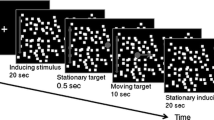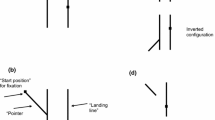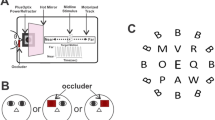Abstract
Translational motion induces retinal image slip which varies with object distance. The brain must know binocular eye position in real time in order to scale eye movements so as to minimize retinal slip. Two potential sources of eye position information are orbital proprioception and an internal representation of eye position derived from central ocular motor signals. To examine the role of orbital proprioceptive information, the position of the left eye was perturbed by microstimulation of the left abducens nerve during translational motion to the right or left along the interaural axis in two rhesus macaques. Microstimulation rotated the eye laterally, activating eye muscle proprioceptors, while keeping central motor commands undisturbed. We found that microstimulation-induced eye position changes did not affect the translational VOR in the abductive (lateral rectus) direction, but it did influence the responses in the adductive (medial rectus) direction. Our findings demonstrate that proprioceptive inputs appear to be involved in the TVOR responses at least during ipsilateral head movements and proprioceptive influences on the TVOR may involve vergence-related signals to the oculomotor nucleus. However, internal representation of eye position, derived from central ocular motor signals, likely plays the dominant role in providing eye position information for scaling eye movements during translational motion, particularly in the abducent direction.






Similar content being viewed by others
References
Angelaki DE (1998) Three-dimensional organization of otolith-ocular reflexes in rhesus monkeys. III. Responses to translation. J Neurophysiol 80:680–695
Angelaki DE (2004) Eyes on target: what neurons must do for the vestibuloocular reflex during linear motion. J Neurophysiol 92:20–35
Angelaki DE, Hess BJM (2001) Direction of heading and vestibular control of binocular eye movements. Vis Res 41:3215–3228
Angelaki DE, McHenry MQ (1999) Short-latency primate vestibuloocular responses during translation. Neurophysiol 82:1651–1654
Angelaki DE, Klier EM, Snyder LH (2009) A vestibular sensation: probabilistic approaches to spatial perception. Neuron 64:448–461
Balslev D, Miall RC (2008) Eye position representation in human anterior parietal cortex. J Neurosci 28:8968–8972
Büttner-Ennever JA, Horn AK (2002) The neuroanatomical basis of oculomotor disorders: the dual motor control of extraocular muscles and its possible role in proprioception. Curr Opin Neurol 15:35–43
Büttner-Ennever JA, Horn AKE, Graf W, Ugolini G (2002) Modern concepts of brainstem anatomy. From extraocular motoneurons to proprioceptive pathways. Ann NY Acad Sci 956:75–84
Chen-Huang C, McCrea RA (1999) Effects of viewing distance on the responses of vestibular neurons to combined angular and linear vestibular stimulation. J Neurophysiol 81:2538–2557
Cullen KE (2004) Sensory signals during active versus passive movement. Curr Opin Neurobiol 14:698–706
Cullen KE, McCrea RA (1993) Firing behaviour of brain stem neurons during voluntary cancellation of the horizontal vestibuloocular reflex. I. Secondary vestibular neurons. J Neurophysiol 70:828–843
Donaldson IM (2000) The functions of the proprioceptors of the eye muscles. Philos Trans R Soc Lond B Biol Sci 355:1685–1754
Eberhorn AC, Horn AK, Eberhorn N, Fischer P, Boergen KP, Buttner-Ennever JA (2005) Palisade endings in extraocular eye muscles revealed by SNAL-25 immunoreactivity. J Anat 206:307–315
Fuchs AF, Kimm J (1975) Unit activity in vestibular nucleus of the alert monkey during horizontal angular accelerations and eye movements. J Neurophysiol 38:1140–1161
Fuchs AF, Luschei ES (1970) Firing patterns of abducens neurons of alert monkeys in relationship to horizontal eye movement. J Neurophysiol 33:382–392
Gauthier GM, Nommay D, Vercher JL (1990) The role of ocular muscle proprioception in visual localization of targets. Science 249:58–61
Gdowski GT, McCrea RA (2000) Neck proprioceptive inputs to primate vestibular nucleus neurons. Exp Brain Res 135:511–526
Gentle A, Ruskell G (1997) Pathway of the primary afferent nerve fibres serving proprioception in monkey extraocular muscles. Ophthal Physiol Opt 17:225–231
Gibson JJ (1950) The perception of the visual world. Riverside, Cambridge
Glennerster A, Rogers BJ, Bradshaw MF (1998) Cues to viewing distance for stereoscopic depth constancy. Perception 27:1357–1365
Green AM, Angelaki DE (2010) Internal models and neural computation in the vestibular system. Exp Brain Res 200:197–222
Green AM, Meng H, Angelaki DE (2007) A reevaluation of the inverse dynamic model for eye movements. J Neurosci 27:1346–1355
Guthrie BL, Porter JD, Sparks DL (1983) Corollary discharge provides accurate eye position information to the oculomotor system. Science 221:1193–1195
Hess BJM, Angelaki DE (2003) Vestibular contributions to gaze stability during transient forward and backward motion. J Neurophysiol 90:1996–2004
Huterer M, Cullen KE (2002) Vestibuloocular reflex dynamics during high-frequency and high-acceleration rotations of the head on body in rhesus monkey. J Neurophysiol 88:13–28
Judge SJ, Cumming BG (1986) Neurons in the monkey midbrain with activity related to vergence eye movement and accommodation. J Neurophysiol 55:915–930
Judge SJ, Richmond BJ, Chu FC (1980) Implantation of magnetic search coils for measurement of eye position: an improved method. Vis Res 20:535–538
Kashii S, Matsui Y, Honda Y, Ito J, Sasa M, Takaori S (1989) The role of extraocular proprioception in vestibulo-ocular reflex of rabbits. Invest Ophthalmol Vis Sci 30:2258–2264
Keller EL (1974) Participation of medial pontine reticular formation in eye movement generation in monkey. J Neurophysiol 37:316–332
Keller EL, Robinson DA (1971) Absence of a stretch reflex in extraocular muscles of the monkey. J Neurophysiol 34:908–919
King WM, Zhou W (2000) New ideas about binocular coordination of eye movements: is there a chameleon in the primate family tree? Anat Rec (New Anat) 261:153–161
King WM, Lisberger SG, Fuchs AF (1976) Responses of fibers in medial longitudinal fasciculus (MLF) of alert monkeys during horizontal and vertical conjugate eye movements evoked by vestibular or visual stimuli. J Neurophysiol 39:1135–1149
King WM, Zhou W, Tomlinson RD, McConville KM, Page WK, Paige GD, Maxwell JS (1994) Eye position signals in the abducens and oculomotor nuclei of monkeys during ocular convergence. J Vest Res 4:401–408
Klier EM, Meng H, Angelaki DE (2006) Three-dimensional kinematics at the level of the oculomotor plant. J Neurosci 26:2732–2737
Knox PC, Donaldson IML (1993) Afferent signals from the extraocular muscles of the pigeon modify the vestibulo-ocular reflex. Proc R Soc Lond Ser B 253:77–82
Lewis RF, Zee DS, Gaymard B, Guthrie B (1994) Extraocular muscle proprioception functions in the control of ocular alignment and eye movement conjugacy. J Neurophysiol 71:1028–1031
Lewis RF, Zee DS, Hayman MR, Tamargo RJ (2001) Oculomotor function in the rhesus monkey after deafferentation of the extraocular muscles. Exp Brain Res 141:349–358
Mays LE (1984) Neural control of vergence eye movements: convergence and divergence neurons in the midbrain. J Neurophysiol 51:1091–1108
McFarland JL, Fuchs AF (1992) Discharge patterns in nucleus prepositus hypoglossi and adjacent medial vestibular nucleus during horizontal eye movement in behaving macaques. J Neurophysiol 68:319–332
McHenry MQ, Angelaki DE (2000) Primate translational vestibulo-ocular reflexes. II. Version and vergence responses to fore-aft motion. J Neurophysiol 83:1648–1661
Meng H, Angelaki DE (2006) Neural correlates of the dependence of compensatory eye movements during translation on target distance and eccentricity. J Neurophysiol 95:2530–2540
Miles FA (1993) The sensing of rotational and translational optic flow by the primate optokinetic system. In: Miles FA, Wallman J (eds) Visual motion and its role in the stabilization of gaze. Elsevier, Amsterdam, pp 393–403
Miles FA (1998) The neural processing of 3-D visual information: evidence from eye movements. Eur J Neurosci 10:811–822
Minor LB, Lasker DM, Backous DD, Hullar TE (1999) Horizontal vestibuloocular reflex evoked by high-acceleration rotations in the squirrel monkey. I. Normal responses. J Neurophysiol 82:1254–1270
Newlands SD, Lin N, Wei M (2009) Response linearity of alert monkey non-eye movement vestibular nucleus neurons during sinusoidal yaw rotation. J Neurophysiol 102:1388–1397
Niechwiej-Szwedo E, González E, Bega S, Verrier MC, Wong AM, Steinbach MJ (2006) Proprioceptive role for palisade endings in extraocular muscles: evidence from the Jendrassik Maneuver. Vis Res 46:2268–2279
Nitta T, Akao T, Kurkin S, Fukushima K (2008) Involvement of the cerebellar dorsal vermis in vergence eye movements in monkeys. Cereb Cortex 18:1042–1057
Paige GD (1989) The influence of target distance on eye movement responses during vertical linear motion. Exp Brain Res 77:585–593
Paige GD (1991) Linear vestibulo-ocular reflex (LVOR) and modulation by vergence. Acta Otolaryngol Suppl 481:282–286
Paige GD, Tomko DL (1991a) Eye movement responses to linear head motion in the squirrel monkey. II. Basic characteristics. J Neurophysiol 65:1170–1182
Paige GD, Tomko DL (1991b) Eye movement responses to linear head motion in the squirrel monkey. II. Visual-vestibular interactions and kinematic considerations. J Neurophysiol 65:1183–1196
Predebon J (1993) The familiar-size cue to distance and stereoscopic depth perception. Perception 22:985–995
Rogers BJ, Bradshaw MF (1993) Vertical disparities, differential perspective and binocular stereopsis. Nature 361:253–255
Ruskell GL (1999) Extraocular muscle proprioceptors and proprioception. Prog Retin Eye Res 18:269–291
Savitsky A, Golay MJE (1964) Smoothing and differentiation of data by simplified least squares procedures. Anal Chem 36:1627–1639
Schiller PH, Sandell JH (1983) Interactions between visually and electrically elicited saccades before and after superior colliculus and frontal eye field ablations in the rhesus monkey. Exp Brain Res 49:381–392
Schwarz U, Miles FA (1991) Ocular responses to translation and their dependence on viewing distance. I. Motion of the observer. J Neurophysiol 66:851–864
Schwarz U, Busettini C, Miles FA (1989) Ocular responses to linear motion are inversely proportional to viewing distance. Science 245:1394–1396
Scudder CA, Fuchs AF (1992) Physiological and behavioral identification of vestibular nucleus neurons mediating the horizontal vestibuloocular reflex in trained rhesus monkeys. J Neurophysiol 86:244–264
Semrau JA, Wei M, Angelaki DE (2006) Scaling of the fore-aft vestibulo-ocular reflex by eye position during smooth pursuit. J Neurophysiol 96:936–940
Skavenski AA (1972) Inflow as a source of extraretinal eye position information. Vis Res 12:221–229
Snyder LH, King WM (1992) Effect of viewing distance and location of the axis of head rotation on the monkey’s vestibuloocular reflex. I. Eye movement responses. J Neurophysiol 67:861–874
Snyder LH, King WM (1996) Behavior and physiology of the macaque vestibulo-ocular reflex response to sudden off-axis rotation: computing eye translation. Brain Res Bull 40(5–6):293–301
Snyder LH, Lawrence DM, King WM (1992) Changes in vestibulo-ocular reflex (VOR) response anticipate changes in vergence angle. Vis Res 32:569–575
Sommer MA, Wurtz RH (2008) Brain circuits for the internal monitoring of movements. Annu Rev Neurosci 31:317–338
Sparks DL, Mays LE (1983) Spatial localization of saccade targets. I. Compensation for stimulation-induced perturbations in eye position. J Neurophysiol 49:45–63
Sparks DL, Mays LE, Porter JD (1987) Eye movements induced by pontine stimulation: interaction with visually triggered saccades. J Neurophysiol 58:300–318
Steinbach MJ (1987) Proprioceptive knowledge of eye position. Vis Res 27:1737–1744
Steinbach MJ, Smith DR (1981) Spatial localization after strabismus surgery: evidence for inflow. Science 213:1407–1409
Virre E, Tweed D, Milner K, Vilis T (1986) A reexamination of the gain of the vestibulo-ocular reflex. J Neurophysiol 56:439–450
Wang X, Zhang M, Cohen IS, Goldberg ME (2007) The proprioceptive representation of eye position in monkey primary somatosensory cortex. Nat Neurosci 10:640–646
Wasicky R, Horn AK, Büttner-Ennever JA (2004) Twitch and nontwitch motoneuron subgroups in the oculomotor nucleus of monkeys receive different afferent projections. J Comp Neurol 479:117–129
Wei M, Angelaki DE (2006) Foveal visual strategy during self-motion is independent of spatial attention. J Neurosci 26:564–572
Wei M, DeAngelis GC, Angelaki DE (2003) Do visual cues contribute to the neural estimate of viewing distance used by the oculomotor system? J Neurosci 23:8340–8350
Weir CR, Knox PC, Dutton GN (2000) Does extraocular muscle proprioception influence oculomotor control? Br J Ophthalmol 84:1071–1074
Zhang Y, Mays LE, Gamlin PDR (1992) Characteristics of near response cells projecting to the oculomotor nucleus. J Neurophysiol 67:944–960
Zhang M, Wang X, Goldberg ME (2008) Monkey primary somatosensory cortex has a proprioceptive representation of eye position. Prog Brain Res 171:37–45
Zhou W, King WM (1998) Premotor commands encode monocular eye movements. Nature 393:692–695
Zhou W, Weldon P, Tang B, King WM (2002) Rapid adaptation of translational vestibulo-ocular reflex: time course, consolidation, and specificity. Ann N Y Acad Sci 956:555–557
Zhou W, Weldon P, Tang B, King WM (2003) Rapid motor learning in the translational vestibulo-ocular reflex. J Neurosci 23:4288–4298
Acknowledgments
We thank Dr. W. Michael King for valuable comments on this manuscript and Rong Chu for his technical assistance in the experiment. The work was supported by NIH grants R01 DC006429 (to S.D.N.).
Author information
Authors and Affiliations
Corresponding authors
Rights and permissions
About this article
Cite this article
Wei, M., Lin, N. & Newlands, S.D. Does orbital proprioception contribute to gaze stability during translation?. Exp Brain Res 215, 77–87 (2011). https://doi.org/10.1007/s00221-011-2873-y
Received:
Accepted:
Published:
Issue Date:
DOI: https://doi.org/10.1007/s00221-011-2873-y




